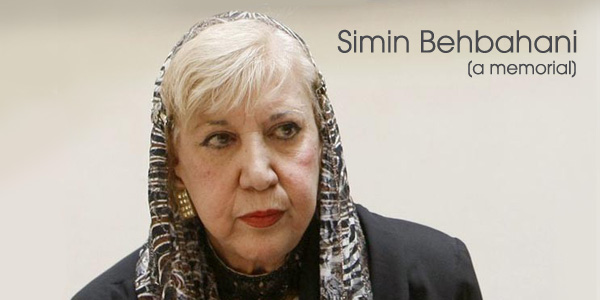
For more than a half-century, the arena of contemporary Persian literature has been graced with the luminous presence of two Simins: Simin Daneshvar and Simin Behbahani. Both women made observable achievements in the realms of prose and poetry. While the former is known as Iran’s first woman short-story writer and novelist, the latter is often regarded the ‘lioness of Iran’ for her bold and courageous revival of the form of Qazale – a quasi-sonnet form – to represent and criticize social problems and inequalities of her time.
Simin Behbahani (Simin Khalili) was born on 20 June 1927 to an intellectual family. Her father, Abbas Khalili, was a poet, writer and editor of Eghdam newspaper who had mastery over Arabic, and had translated Ferdowsi’s The Book of Kings into Arabic. Her mother, Fakhr-e-Ozma, also a poet and a French teacher, was a member of the “Association of Patriotic Women”. Simin started writing poetry as a teenager, and after a period of experimentation with Nimaic verses, she turned to Qazale as the main framework for her poetic creations. She passed away on 19th August 2014 in Tehran, having lived a full prolific life of valor and veracity.
In her long journey of formal experimentation practiced from The Broken Lute (1951), Chandelier (1955), and Resurrection (1971) to Paper Dress (1992), A Window of Freedom (1995), and Maybe It’s the Messiah (2003), Behbahani achieved stunning innovations in the form, rhythmic patterns, and the subject matter of the old Qazale. She had admitted in an interview that her primary works were tracing those of Parvin Etesami, “but soon I could get out of the command of my mentors and quietly I chose a path of my own that was independent. I am still walking on the path of independence. My work mainly considers the Qazale. I’ve reformed the contemporary qazale, and appropriated it so deeply that no more does it resemble the preceding form. That is, the only remaining part of the so-called Qazale is its geometric format, whereas in content, vocabulary and meter, I have hit innumerable records of innovation.”1 Opposing the Iranian poet and critic, Reza Baraheni’s claim that the static structure of Qazale, like that of a sonnet, is retrogressive and hackneyed, Behbahani reasoned that Qazale as a kind of poetic form will never die: “I should state, however, that to compose poems in the manner and style of the past is just useless today. One should accompany the form with fresh thought and expressions and subject matters peculiar to this time and period in order to distinguish today’s Qazale from its former peers. All in all, Qazale may be more appropriate for this era than any other forms of classic poetry.”3
Simin believed ‘contemporariness’ to mean “[the people] want you, want to read you; that you be a part of their destiny, that they be part of your destiny” Few other contemporary poets may compete with her in contemporariness as such. While Simin’s earlier poetry was concerned with the sociopolitical issues of her time, from poverty and the agony of peripheral residents of large cities such as servants, part-time workers, prostitutes and thieves in the 1940s, to more decisive incidents and problems in society including the state of women, she did not succumb to seclusion after the 1979 revolution like so many other intellectuals of the time. Her post-revolutionary poems offer a vivid mirror of the sorrows of a war-stricken nation: portrait of soldiers and combatants injured during the imposed war, martyrdom, bereaved mothers seeking signs of her lost children, aftermath ruins of war and great quakes, and a ceaseless search for the true meaning of freedom, are but few examples of the scenes artistically put into novel poetic meters. As the poetess moved away from poetic conventions, everyday life became a more dominant motif in her poems and in later phases of her career, while aging and motherhood endowed her with a peerless sense of affection and toleration towards her opponents.
-
https://www.youtube.com/watch?v=8XPtdzR1rss ( mine)
-
Karnameh: 39, quoted in “A Survey of the Elements of Contemporary Life in the Poetry of Simin Behbahani,” Kavoos Hasanli & Maryam Heidari. Social & Human Sciences, Shiraz University: 2007.
http://www.hasanli.ir/far/handler.aspx?detail=95 (trans. mine)
-
Simin Behbahani, Yad-e Baazi Nafarat, Alborz: 1999. Quoted in “A Survey of the Elements of Contemporary Life in the Poetry of Simin Behbahani,” Kavoos Hasanli & Maryam Heidari. Social & Human Sciences, Shiraz University: 2007. http://www.hasanli.ir/far/handler.aspx?detail=95 ( mine)


Leave a Reply